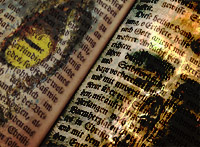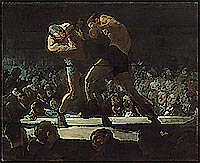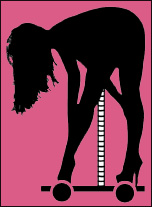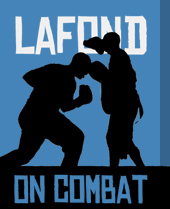“You have stressed how real dangerous men on the street tend toward silence and a quiet demeanor. However, you readily admit that the people committing the most violence, and who are usually successful, are loud while being violent, namely blacks and cops. Also, I can’t help but think of Brave Heart and other movies of ancient battle that show warriors using battle cries, which brings to mind the Kia yells of karate people and the hissing of some boxers as they punch.”
-Brad
Brad, you have raised a lot of thoughtful points, which are all part of the actual auditory aspect of violence.
The lion is a perfect example of an alternately silent and loud predator. The roar of the lion is the most paralyzing sound in nature, guaranteed to have us bald-ass monkeys shivering in our paw prints for that crucial second needed to pounce on us and rip our necks open.
On the other hand, there was a famous lion who was being hunted for its man-eating crimes by a white hunter and his guide. The lion, eluding his hunters through stealth, doubled back and tracked the African guide to his home, where he killed him. The lion used silence until that crucial tiny window in time when a roar would momentarily stun his quarry and make him ripe for the kill.
In terms of humans, the female’s relationship to danger is naturally to make noise in order to alert the men, who are actually equipped and able to deal with danger. Also, if women tend to be loud while attacking each other, that warns the men that their property are potentially damaging one another so that they can drag the she-devils apart.
Generally speaking, with humans, the violent actor who utilizes noise is less lethal and is more apt to be bluffing, warning, attempting to gain control, or engaging in status-building social behavior.
Conversely, the silent violent actor is more likely engaged in killing, abduction, or rape.
The violent hoodrats of urban America use verbalization effectively in the following ways:
1. To lure victims into compromising behavior, like checking for the time or handing over a cigarette
2. To frighten a coward and gain compliance
3. To develop cohesion among his fellows
4. To antagonize a potential victim into saying something antagonistic so that associate potential aggressors will feel justified in piling on
These verbal habits fail under the following circumstances:
1. When dealing with law enforcement personnel, who are also verbal-based aggressors and are better trained and better armed, verbal aggression results in arrest, injury and death.
2. When dealing with silent aggressors, these loud mouths are laying out their pattern of aggression for their antagonist, who is clued in and free to interrupt the noisy ritual at his lethal convenience.
In the ancient world, and in primal warrior societies, we have two extreme models of verbalization and violence.
A group such as the !kung bushman of Southern Africa will silently kill from a stalking ambush with mechanical weapons, or bows.
A group such as the Maori of New Zeeland, who used non-mechanical muscle powered weapons almost exclusively, will develop chanting rituals to enhance their muscular effort just as boxers and power lifters do. Such habits will develop into war dances, war songs and battle cries to unite, synchronize, and motivate part time warriors in the ancient and medieval world, such as the Greek Hoplite and the Scottish Highlander.
These two traditions are hybridized in sophisticated advanced stone age hunter-warrior types such as the Native American warrior of many tribes, who hunted his enemy in utmost silence and then used a war cry when closing, and chanted death songs when things went against him.
But even in the ancient world, the silence of the apex warrior—the professional—loomed, in the form of the Spartans who marched to the sound of flutes and fought in utter silence, which totally freaked out their enemies. The Roman Legionary fought in individual silence so that voice and whistle commands could be heard, particularly over the roar of the barbaric enemy.
Through early modern times the grunting and roaring of a hero knight or axe wielding highlander was perfectly appropriate, with crying out aiding strenuous effort even as the kia cry in karate aids the power of a reverse punch. However, once firearms became the main weapon, the discipline of silence among leaders and professionals became the trademark of the warrior.
Again, verbal aids to combat, such as war cries, like the rebel yell used by Confederate troops to frighten poorly trained and previously sedentary Union conscripts, are effective against untrained and undisciplined soldiers. The cries and chants of the Zulus and Madis who fought the British in Africa were terrifying. However, the discipline of the British soldier and the cool heads of the officers rendered these terror tactics ineffective.
Even today, the most feared war fighter is the sniper, with their status having risen to mythic proportions on the battlefield as the bringer of specified, personal death out of the silent distance.
Before wrapping up, we must differentiate between the exertive noise of the fighter and the bitching, trash talking and wolfing of the hoodrat and the overaggressive females that raise such easily discouraged and defeated aggressors.
The Auditory Aggression Matrix
This table charts increasingly effective aggressiveness as typified by verbal cues.
1. Silently cowering
2. Bitching
3. Appeasing with conversation
4. Trash talking
5. Reasoning with conversation
6. Wolfing
7. Silent, aware
8. Raging
9. Silent, not backing down [coiled]
10. Commanding
11. Silent, positioning for action [edgy]
12. Silent, approaching with intent
Usually, the way situations resolve themselves between a #4 aggressor and #9 or #11defender is perfectly illustrated by the following video. In most cases the verbal aggressor backs down, unless he is stupid and drunk and…











I believe what James is trying to communicate when he tells us that we should avoid verbalizing when confronted by black hoodrats is that we should be thinking about and planning our opening moves as well as what our trigger line will be for if and when the confrontation goes physical (AKA thinking tactically or “killing them in your mind”), rather than thinking about our clever verbal comeback to the hoodrat’s insult. To do otherwise is to set yourself up for a sucker punch (a “king hit” for our readers in OZ) that will nail you in midsentence of your witty retort. What one can discern from studying the copious Youtube videos on the subject is that sucker punchers and knock out game practitioners typically do two things: 1. Wait for the victim to take his eyes off them before launching their attack. 2. Telegraph their blow (i.e. draw back their fist or wind up their body in preparation to throwing the punch). What better way to get your opponent to take his eyes off you for a moment and remain stationary than by causing him to think about what he is going to say next? Human beings really are not able to multitask; our attention is mostly going to be focused on one thing. In the first video clip, notice how the black assailant winds up like John Wayne before throwing his sucker punch while his oblivious white victim stands stock still within easy arm’s reach, running his mouth off and seemingly waiting patiently for the blow to land and knock him out. youtube.com/watch?v=CXOdwAgJ0wc&feature=youtu.be (N.O. Man assaulted in his front yard). In the second video clip notice how the sucker puncher in the stripped polo shirt waits for his opponent to look away before executing his assault. youtube.com/watch?v=Z0dqm957raU (when keeping it real goes wrong - polo sucker punch). What James does by remaining silent and keeping his eyes on his hoodrat antagonists as they “wolf” or “woof” at him is to set them up with a disconcerting miscue. One that unexpectedly deprives them of their go signal making them uncertain as to how to proceed. This seems to deter them from their course of action as they are unable to adapt to the unfamiliar behavior. James is of course responding to the familiar M.O. of the black ghetto dwellers and using his knowledge of their “doctrine” and psychology to confuse and thwart them. As always, thanks for the advice James.
“Again, if the trumpet does not sound a clear call, who will get ready for battle?” - 1 Corinthians 14:8 (NIV)
Thank you, sir, and for the trumpets and link as well.
For those who are interested—all of us—there is youtube feed featuring white dudes slaughtering black dudes.
Notice that the typical niցցer rat female is pumping the young unarmed bro to take legal action against a 67 year old white man, that the bro attacked. Disgusting animals.
Very interesting article, and something I've given a lot of thought to. For various reasons, I'm frequently exposed to people you might term 'professionally dangerous', and, consequently, have tried to cultivate the same qualities in myself. My experience of those with highly trained lethality is that they are incredibly quite, and unassuming. Even in direct confrontation, they are able to remain disarmingly charming and softly spoken, yet exude menace and what you might term 'frame control'. At the end of the day, composure under extreme stress/duress will always mark someone out as a consummate professional, who is relaxed and comfortable in those situations. That in itself, in my experience, is significantly more intimidating than a load of shouting and threats.
I always thought the great Oliver Reed did a good job of conveying this approach in this clip, which is also pretty funny. youtube.com/watch?v=OmnK0ty0RBE
Thank you so much for this link, and the 'frame control' concept.